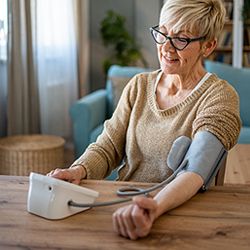
Heart health is an important part of overall health. One way to ensure our hearts are working well is by checking our blood pressure at home.
Blood pressure, or BP, is the force of blood pushing against artery walls. High blood pressure can damage arteries by making them less flexible. This can decrease the flow of blood and oxygen to your heart and may lead to heart disease.
High blood pressure is a leading cause of heart disease and stroke and is one of the most common and dangerous medical complications during pregnancy. High blood pressure (or hypertension) is known as “The Silent Killer” because many people do not experience symptoms or know that they have it.
The good news is that by checking your blood pressure and adjusting your daily habits, you can improve your health. You can even check your blood pressure at home with the right tools and a few easy steps.
Taking your blood pressure at home is simple with an at-home blood pressure monitor.
How to Check Your Blood Pressure at Home
Before You Start
- Take your blood pressure at the same time every day
- Do not smoke, exercise, or drink caffeine for 30 minutes before taking your blood pressure
- Empty your bladder
- Relax
- Avoid talking or using your cell phone
During Your Reading
- Make sure your BP cuff fits well and is in the correct position over bare skin
- Keep your arm on a flat surface at heart level — a table is perfect for this
- Sit up straight and tall and keep your feet flat on the floor
- Remain quiet
- Follow directions provided with your home BP cuff
After You Take Your BP
- Write down readings and bring your log with you to your next Primary Care Provider (PCP) appointment
- If you have questions or concerns call your PCP
Registered Nurse Nicholas Stasinos says that one of the best benefits of monitoring your blood pressure at home is that it helps clinicians get the full picture when it comes to your health and allows them to better customize a treatment plan for you.
“By taking your blood pressure accurately at home, you are giving a more precise view of how well controlled your overall blood pressure is,” he says. “When clinical staff receives accurate information, it helps us to determine whether medication may need to be adjusted or if there are other ways we can help to better control your blood pressure.”
What do my blood pressure readings mean?
Blood pressure is measured by two numbers:
- systolic blood pressure (the top number)
- diastolic blood pressure (the bottom number)
The systolic number is the pressure your arteries have as your heart is squeezing. A normal reading of systolic BP is less than 120. The diastolic number is the pressure your arteries have at a relaxed state between heartbeats and should be less than 80. To better understand your blood pressure readings, visit our chart to learn where your numbers fall.
Consult your provider if your blood pressure is higher than 180 systolic or 120 diastolic, or if you have symptoms or questions that concern you.
Where can I find an automated or digital home blood pressure cuff?
Automated or digital home blood pressure cuffs are easy to use. They work at the press of button and show results on a digital screen. Some will even store your data or create an average of your results.
Blood pressure cuffs are widely available, but the most dependable models are recommended by the American Medical Association. You can find a list of AMA-recommended BP cuffs at validateBP.org.
Heart Health for Life
Healthy eating and regular exercise play a big part in lowering blood pressure. Things you can do include:
- Eating less salt
- Choosing healthy foods such as vegetables, whole grains, fruit, fish, lean poultry, and low-fat dairy products
- Eating less red meat
- Quitting smoking
- Limiting alcohol
- Exercising for 30 minutes daily
- Losing weight
Visit our Heart and Vascular Program to learn more about how Baystate Health can help you on your heart health journey.